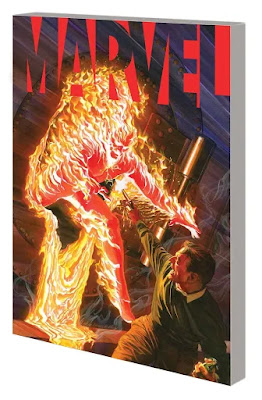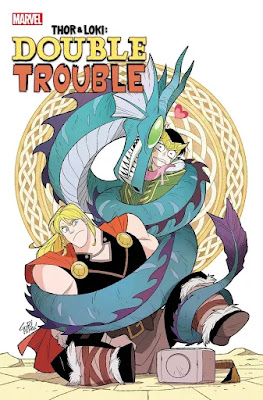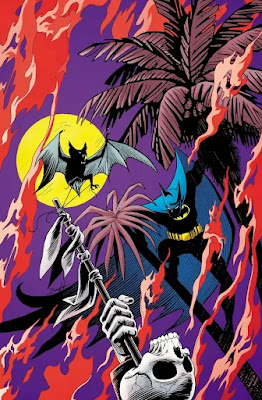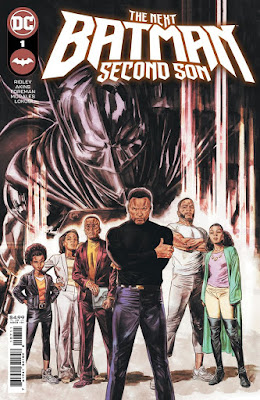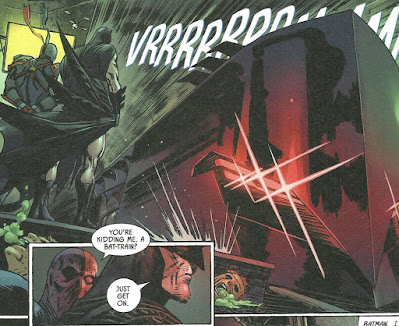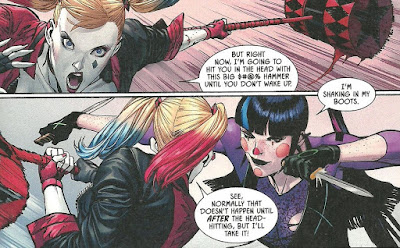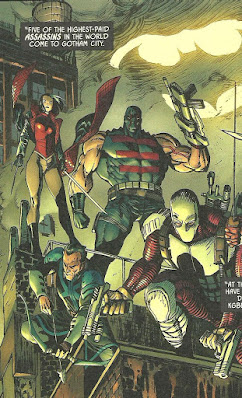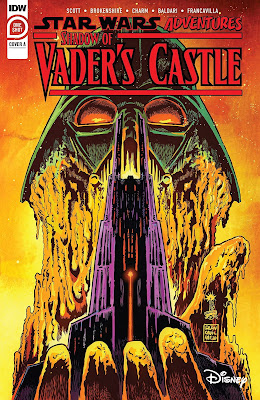It can be extremely sad to consider the career of writer Chuck Dixon these days, as his bibliography includes such recent embarrassments as
one of those goofy Zenescope miniseries that seem to mainly be excuses to publish variant covers and some comics I'd rather not even mention in passing so as not to embarrass him further. This is a guy who carried a huge amount of DC's Bat-office's workload for years, but whose gross politics have made him something of an industry pariah, apparently. I honestly hope DC keeps collecting and publishing his work, so he can make enough royalties to live off without having to write some of the trash he's been producing of late.
Now, knowing Dixon's politics can also make reading his old stuff a bit of a challenge to read and, admittedly, it took some work to essentially convince myself to forget Dixon the person while reading this book by Dixon the writer. I...don't like doing that, and maybe I shouldn't have spent $40 on this book at all. I could tell myself I was buying it and reading it for the Graham Nolan art, which, in large part I was, but Dixon is obviously integral to these comics, and while I did wrestle with it a bit, I did choose my desire to read some decent Batman comics from the '90s over making sure I spend my where it could do the most good. I'm not proud of myself for the decision.
This stretch of stories falls roughly between the end of the "Contagion"/"Legacy" crossovers and the beginning of the "Cataclysm"/"Aftershock"/"No Man's Land" cycle of stories that filled out the end of the decade.
There are a couple of arcs within these comics, including one in which The Riddler returns (accompanied a pair of sexy gun molls who did not ever gain a Harley Quinn level of popularity) with a scheme that forces Batman to team up with Cluemaster; another in which Batman faces off against hitmen Deathstroke and Gunhawk (who the new character Gunsmith, see the Batman: Their Dark Designs review below, rather echoes visually); another introducing the bionic villain Gearhead; and the John Jones/Martian Manhunter two-parter I recently wrote about during lockdown.
These are all fine, and Dixon was always talented when it came to writing Batman comics that read a bit like little paper action movies, just as all of these do. Of these, the Martian Manhunter story is probably the best, and the Deathstroke/Gunhawk one the weakest, as it includes one of the more belief-beggaring examples of an omnipotent Batman I've ever read (despite his aversion to guns, here it is revealed that Batman is a master of long-range sniping, he just hates doing it), and has Batman beating up Slade pretty good, something that's never felt right to me after I read that one fight in Deathstroke #7. (This was during Deathstroke's short-lived black-and-blue costume phase; I've certainly seen worse Deathstroke costumes in the past decade or so!)
The book also contains several very short, done-in-one stories that are particularly strong, though.
There are a pair of done-in-ones featuring low-level crooks with varying degrees of luck (one of these is the Aparo-penciled story, inked by Stan Woch, which was a ghost story produced for DC's 1997 "Big Head" month of done-in-one, good-jumping-on-point stories, each of which appeared under a portrait-style headshot cover...a theme month I wish they would repeat every year or two).
And, finally, there's the cover story, in which we follow Bruce Wayne on a date, and see him doing Batman stuff on the sly, never changing out of his tuxedo in favor of his bat-suit.
While these shorter stories are perhaps a bit better than the longer ones in this collection, all of the contents of the book range from, at worst, pretty decent to, at best, quite strong.
I originally purchased these specifically to review, as the fact that IDW was relaunching their all-ages Star Wars ongoing seemed somewhat noteworthy, even if the specific stories within weren't terribly so (the first issue was released last month, in October, while the second issue was released this month). I didn't end up reviewing them, though; instead
The relaunch seems like a rather Marvel-ous move—in fact, Marvel has already relaunched their main ongoing Star Wars title once since they reacquired the license in 2015, and relaunched the Darth Vader ongoing repeatedly—as there doesn't seem to be any particularly strong and compelling reason to do so after just three years and thirty-some issues.
As for the contents of these issues, the first issue includes a lead story by writer Michael Moreci and artist Ilias Kyriazis, which continues into the second-issue. Entitled "The Obstacle Course" and set somewhere between the end of The Last Jedi and Rise of Skywalker, it features Finn and Poe setting up their own version of a Jedi training course for Rey, in the hopes that, as Poe explains, "The faster Finn and I get you all trained up, the faster you can join us on missions." Unfortunately, the seeminly-deserted moon they chose to build their course on is the secret hideout of a band of space pirates, who aren't pleased to find the heroes running around.
The first issue's back-up story is written, drawn and colored by frequent contributor Nick Brokenshire, and basically just retells a sequence from Empire Strikes Back from Darth Vader's point-of-view. with a funny (to me) cameo featuring a wampa.
The second issue's back-up is a collaboration between writer Sam Maggs and artist Davide Tinto (making his first of two appearances in this post), and is set in the same time period as the two-part lead story. It stars Supreme Leader Kylo Ren, attempting to subdue a planet, and finding himself intrigued by a woman who dares stand up against him, even though she knows how dire the consequences will be.
Jaxxon was a success, because he's back this year too, although this time he's drawn on the cover by Maruicet, rather than
. The interior artist is Francesco Gaston, who draws writer Cavan Scott's tale of the galaxy's
famous smuggler, Jaxxon.
Jaxxon in the middle of a fight over sabaac when he discovers he's an extremely wanted rabbi—er, Lepi. Bounty hunter Dengar is after him to collect a bounty on his head, the Empire is after him because his former partner stole some important Imperial cargo and the Rebel Alliance is after him because they'd rather get their hands on it than let the Empire have it. This means a run-in with Han Solo, Chewbacca and a young Luke Skywalker, who is used here, oddly enough, mostly as Han's muscle.
I'm sure I mentioned it when discussing last year's annual, but I like the implication of a professional rivalry between Han and Jaxxon, and so it's fun to see the pair sharing scenes here, and to see him interacting with Chewie and Luke as well (Gaston draws a pretty great Luke).
I'm not sure if this alien race has appeared elsewhere before, but I really like how this one alien looks...you know, the jelly fish-ish one. I was also particularly impressed by Gaston and color artist Charlie Kirchoff's rendering of Dengar's laser blasts and some of Luke's light saber effects.
After the full-length, 20-page Jaxxon story, there's a 10-page back-up starring droid bounty hunter IG-88 by Nick Brokenshire, featuring a one-panel cameo by Dengar, which I suppose makes Dengar the connective tissue between the two stories...?
Brokenshire's art is always a pleasure to read, and I like seeing IG-88—or the "IG" model droids in general, I guess—in action, even if just the implied "action" of comics story-telling. Beyond the most action-y action, like a five-panel sequence in which he takes a blaster and a giant scalpel-like weapon to a bunch of other IG droids, I like the way Brokenshire animates the character's movements, from the way his poncho ruffles when he whips out a weapon, to the way his wrist joint bends on page six so he can use the "palm" of his pincer-like hand to slam his victim onto a table.
Star Wars Adventures: Shadow of Vader's Castle (IDW) In lieu of a third Vader's Castle miniseries of scary stories being told within a Star Wars story, this year IDW has produced a single 38-page, $7.99 special that abbreviates the formula a bit, with fewer and shorter stories-within-the-story.
Writer Cavan Scott is responsible for this one as well, and its four artists are all alums of the previous series: Derek Charm, Nicoletta Baldari, Nick Brokenshire and Francesco Francavilla, the latter of whom of course drew that awesome cover.
Set sometime just shortly after the Battle of Endor, when the entire galaxy is celebrating the downfall of the Empire and Darth Vader, the story stars a pair of young Mustafarian natives who lives in the shadow of Vader's Castle (Hey, that's the title of this very comic!) Even with the Empire defeated and Vader gone, his castle still stands and still casts its shadow, so perhaps they could do something about it? Something involving explosives?
As the pair embark on their quest, they aren't dissuaded by a former miner's scary story, nor one that one of them tells the other, nor even one coming from a mysterious voice of a prisoner being held within the castle. These three tales, and an opening story featuring the miner as a young man, comprise the stories within the story, while Francavilla draws the passages connecting them to one another, that of the young Mustafarians and their attempt to destroy the castle.
Derek Charm draws two stories. In the opening one, Anakin Skywalker is on Mustafar and has turned to the dark side—but hasn't yet been chopped up and burned during his fight with Obi-Wan— and he stalks about a lava mine, his mind affected by hallucinogenic lava fumes that makes him see the twisted, scary shapes of Jedi. This is a really bravura story, as Charm's simple style is pressed into service to draw one scary-ass Anakin, who seems more frightening here with his wild, golden, almost glowing eyes, and to make scary, red smoke phantoms of the heroic Jedi.
Charm's other story is an origin story of the Vanee, Vader's servant. It too involves the red plumes of gasses, and Anakin's yellow eyes.
The other two stories are Baldari's story of a young Twi'lek forced to steal something for Palpatine that is a weird homage to Disney's Aladdin, and Brokenshire's story of a mad Imperial scientist with a mad scientist's typically mad and circuitous plan. While Charm is my favorite Star Wars artist (and one of my favorite artists of the moment, period), both Baldari and Brokenshire have extremely distinct styles, and their contributions help make this a winning, visually interesting comic.
If you're worried the young Mustafarians' plans to demolish the castle mean an end to these Halloween seasonal miniseries, don't; if I may spoil the ending, their explosion goes off, but it fails to topple the castle. And whatever may have befallen Vader above Endor, as far as the mad Vanee is concerned, his master can and will live again, according to a voice speaking to him.
The last page of the book features a ghostly hand like Vader's rising from the lava (an image similar to the one that adorns one of Charm's variant covers for the book), and the slug "To Be Continued In... Ghosts of Vader's Castle."
Teenage Mutant Ninja Turtles #109, #111 (IDW) My local comic shop continues their ongoing efforts to convince me to give up reading serially-published comic book-comics completely, dropping TMNT from my pull-list for the second time in less than a year. I didn't realize I was missing issues of the series—I only go to the shop about once a month now, so, yeah, I know it's my fault too for not paying better attention—until I saw #111 on the rack. So I bought these two off the rack, but they didn't have any copies of #110.
I did read them both and they are both pretty good, but man, it would be nice to be able to read the series in the order in which the issues are published! Sophie Campbell still hasn't returned to art chores, which are here handled by Jodi Nishijima. It's nice art, and close enough in style to Campbell's own that Nishijima makes a perfect fill-in artist.
There's a pretty powerful scene near the end of #111 where Mona Lisa, who was a human being that was mutated into a lizard during the mutagen bomb event that created Mutant Town, calls her parents in a video call so she can show herself to them and they react very badly which feels like it's about a lot more than simply being a mutant...or, perhaps, a "mutant."
In fact, I think there's probably an good piece by a smart, insightful writer to be written about how Campbell's run has used mutant for a metaphor in the way people used to talk about the X-Men as minority or outsider stand-ins, but its infinitely more effective here, as not only is the metaphor used more directly, but, well, the X-Men were all good-looking, hot-bodied superheroes with awesome (if sometimes inconvenient) powers, whereas the Mona Lisa or Jennika characters have had radical, physical transformations, and there's a great deal of time and attention paid to their getting used to a having a whole new body, and characters trying to make a normal life in the body they suddenly have, or have evolved into (And it's somewhat remarkable how much of the run has been devoted to more-or-less normal life; there are only two brief fights in #109, both of which are misunderstandings).
Now please
join me in looking very, very closely at each of the mutants that Kevin Eastman has drawn on the cover of #108, and meeting each of their eyes, won't you...?
Yeah, that's rewarding, isn't it...?
Superman 80-Page Giant #1 (DC ) I've found myself increasingly looking backwards to older comics to fulfill my need for super-comics, either in trade or in back-issue, as there are so many I skipped in the first decade or so that I was reading comics on account of my more limited budget, and the fact that after DC's increasingly mushy continuity, the heroes I "know" are harder and harder to find. At least those from the '90s are familiar enough that I have a sense of their stories without having to consult Wikipedia, or add and subtract comics I've read from memory, based on the events of various crossovers I may or may not have read.
This was five dollars when it was published in 1999, which sounds like nothing today, but was obviously enough to keep me from buying it when I was a senior in college. I am assuming the other reason I skipped it was that the cover announced a couple of the characters appearing within—Scorn! Mxyzptlk! Capt. Tomorrow!—rather than a couple of the contributors. Because three of my favorite comics creators have stories in these pages, and there's a Hitman-adjacent story, in which Sixpack teams up with the Man of Steel.
Had 22-year-old Caleb known that this comic contained art by both Norm Breyfogle and John McCrea, and a Sixpack short written by Garth Ennis, I assume he would have parted with that five dollar bill. I'm sort of glad he didn't, though, as it meant that 43-year-old Caleb got to enjoy these stories this year.
The Breyfogle story is written by Mike Barr and inked by Brett Breeding, and allowed the Batman artist to draw DC's other iconic hero, lending Superman the same sort of semi-mythological grandeur he imbued the Dark Knight with. It's only ten pages, but it is full of great Superman imagery: Superman in a classic flying pose, swooping above traffic in a canyon formed by rows of skyscrapers; Clark Kent avoiding Lois to duck into the Daily Planet store room, lower his glasses and un-button his shirt; Superman breaking out of a cocoon of quick-drying cement by flexing; Superman posing on the Planet rooftop, his hands on his hips, his stance wide; Superman struggling beneath the weight of a giant demon's crushing limb, its shadow turning Sueprman into a silhouette with only his S-shield and his white, pupil-less, Batman-like triangle eyes visible. And, believe it or not, more.
The story revolves around a small-time hood who, after prematurely calling off a heist when he spots Superman flying by, tries to make a name for himself by being the guy to kill Superman. His increasingly dangerous ploys work, until he meddles with forces beyond himself. It's a pitch-perfect short story of its type and, obviously, an ideal showcase for the late, great Bryefogle.
The McCrea story is not the Ennis-written Sixpack one, as one might expect, but rather a collaboration with writer John Rozum in which Superman faces what seems to be a new villain, The Utopian. I was familiar with McCrea's art back then, obviously, but it was still something of a surprise to re-encounter it now, after having read his more recent work like, say, Dead Eyes. His art has changed a lot over the years, getting sharper and more detailed, but it was definitely fun to spend some more time with '90s McCrea; I always liked the way he drew big, baggy clothing, and Rozum gives him plenty of neat stuff to draw, as the Utopian's mental abilities allow the character to affect Superman's perceptions, so we get to see McCrea's version of ant-headed Superman and what must be the first and only appearance of chinchilla-in-a-gondola-headed Superman.
Ennis' contribution is drawn by one-named pencil artist Nelson, with inks by Jimmy Palmiotti (which likely explains why a group of muggers holding up a "Mrs. Conner" to get "money for methamphetamines an' comic books" look like Joe Quesada and Jimmy Palmiotti). Tommy, Nat and Sean all appear in about four panels, in the story's framing sequence, with what falls between being, like so many of Sixpack's superheroic adventures, merely a booze-addled dream.
In that dream, he flies to Metropolis to "spend some time pursuin' justice, fightin' the never-endin' battle" and to "smite some evildoers an' transgressors." It is essentially a series of Sixpack's unprovoked, extra-legal attacks on suspects, starting with Lex Luthor, which Superman stops, each time launching into a lecture about how they need to work within the law, during which Sixpack wanders off to do something else heinous. I'm not sure if this ever made it into any of the later Hitman collections, but it probably ought to have.
The biggest surprise of the anthology was "Too Close To Home," a story by Danny Fingeroth and Bob McLeod. In it, Superman finds himself alarmed by a new comics strip called Captain Tomorrow, about a caped strong man who is secretly the staff artist at a newspaper, where he's dating a fellow staffer named "Cloris Danes." It all sounds, well, too close to home for our concerned hero, who investigates cartoonist Willie Schuman, first as reporter Clark Kent and then as Superman.
Schuman's secret is an unexpected one, and the story actually has a nice, touching ending; it's a great portrait of an old-school, Golden Age cartoonist, really (I was reading Megan Marguiles' My Captain America, her memoir of her relationship with her grandfather Joe Simon, when I read this, and Schuman reminded me a bit of Simon).
The remaining three stories include one about Scorn attempting to join the work force by Dan Jurgens, Ron Wagner and Breeding; a Mr. Mxyzptlik story by Dan Abnett, Andy Lanning and Graham Higgins which is a long riff parodying various television shows popular at the tim; and "The Unstoppable Solvent," by Barr, Breeding and pencil artist Will Rosado, which is basically a long walk to a punchline-like joke, with lots of Superman using his powers to problem-solve on the fly during said walk.
All in all, this was $5 well-spent, especially in 2020 dollars. I really need to try to find all the other millennial 80-Page Giants I missed the first time around. There were almost 30 of them, it looks like, and I bet I bought and read only about a third of them.
Unicorns Aren't Horny Vol. 1 (Seven Seas Entertainment) Except, of course, they quite literally are, and, in fact, their horns are their single defining characteristic, the thing that differentiates Uni, the Unicorn on the cover of
Unicorns Aren't Horny, from a white horse with a colorful mane and tail. And Uni is figuratively horny too, for Emuko's virginity—not in the way that some humans might get turned on by virgins of course, but because virginity is kind of a unicorn's thing.
Manga-ka Semi Ikuta takes that one aspect of medieval unicorn lore, and basically builds Uni's personality and the premise of the comic around it. Emuko is unlucky at love, and is nowhere near as happy about being a young adult virgin as her weird roommate is, but that tension drives the odd-couple comedy of the book.
After a four-page introduction, the book shifts to a series of four-panel "tower" style comic strips for some pages, and then shifts back to a more familiar comic book style. The gags in the tower strips mostly revolve around their weird relationship vis a vis Emuko's lonely singe life and Uni's near-psychotic interest in it (Some of the jokes would be extremely creepy were he a human rather than a unicorn, but the fact that he is, and is drawn so simply and cartoonishly, allows him to get a way with jokes he might not otherwise be able to...like, for example, when he buys Emuko a chastity belt for Christmas (Not that what it is or how it works is necessarily explained in the manga).
Though many of the jokes revolve around sex and/or the lack of it, the manga itself isn't really very sexy, owing to the style it's drawn in. In fact, the title page, depicting a nude Emuko with her hand on Uni's horn, is probably the sexiest image featuring these characters and, well...
The heroine is nude and posed suggestively (there are a few jokes in which Uni's horn is alluded to as a penis substitute, although he also has a penis, which we never see), but the look on her face should deflate any erotic content from the imagery.
Like a lot of humor manga, my impression after reading the first volume was to wonder just how long the creator could keep going with the relatively limited scope of the premise and keep it engaging and funny. I'm generally surprised by the answer. The late-in-the-book introduction of another character with her own magical beast roommate makes me suspect that this could go on for a bit, as the cast is extremely gradually expanded.
BORROWED:
Batman Vol. 1: Their Dark Designs (DC Comics) I did not have great expectations for writer James Tynion IV's first story arc on
Batman, expecting it to be a fill-in run while the publisher got its ducks in a row for the next
Batman writer, who I assumed would be Brian Michael Bendis (He's gotta get on Batman
eventually, right? Tynion had already written some fill-in issues and arcs on the title, and had recently completed his own substantial run on sister book
Detective Comics—it seemed like he might just be the guy who was in the room when the editors realized Tom King's four-year, 85-issue run was finally coming to an end.
That, and Tynion was being paired with artist Tony Daniel, whose work I am no fan of, and whose solicited covers for the initial issues left a lot to be desired, all resembling sketches that the colorist would finish for him (comparing the solicited images with the ones that were published, that does indeed seem to have been the case).
So I was quite pleasantly surprised to see that this met and surpassed my (admittedly low) expectations.
I think much of that has to do with the presence of Guillem March, one of my favorite Batman artists, who draws the largest chunk of the ten issues (and one special) collected herein, enough that he's the top-credited artists and the one whose name is on the cover; Daniel only draws one issues and the bulk of the covers.
Credit where credit is due, though, Daniel does come up with a pretty fascinating Batman plot...albeit one that would have worked better when continuity was still a thing at DC Comics, as it involves the evolution of Batman and his villains from the era of the Caped Crusaders to that of the Dark Knight.
A group of high-profile assassins—Deathstroke, Cheshire, Merlyn and new characters Mr. Teeth and Gunsmith—are in Gotham City, going after high-profile targets, which reminds Catwoman, The Penguin and The Riddler of a particular plan from a long time ago. Catwoman tries to figure things out on her own while Batman is battling the assassins, but eventually comes clean. Meanwhile, Harley Quinn joins the two heroes.
Behind it all is a new villains called The Designer, a sort of master criminal from a bygone age who has a Batman-like archenemy referred to simply as the detective (both are original characters, of which there are a pleasantly surprising number in this collection, particularly given how much use Tynion made of Chuck Dixon, Alan Grant and Denny O'Neil creations in Detective; I do wonder if DC's Golden Age was still in tact if maybe the nameless hero might have been The Crimson Avenger or Midnite or somehow extant but obscure). Apparently sometime back in the day, when Dick Grayson was still Robin, The Designer called The Joker, The Riddler, The Penguin and Catwoman together for an evening of meetings, and essentially predicted the ways in which they would evolve, seeing their futures through his own meticulous planning; he was going to give them their criminal schemes of the future now, way ahead of schedule, before Batman was ready for them, but thing went awry with The Joker, who ultimately murders The Designer.
Now, however, The Designer is back, and his plan is in action.
Meanwhile, Tynion seems to be balancing some world-building of his own, with new, sometimes-kinda-cool, sometimes-kinda-dumb, sometimes-that-admixture-of-the-two-particular-to-superhero-comics gadgets and vehicles, some original characters that here includes Punchline and an evil banker to the villains known as The Underbroker and setting up future plots, which proved this wasn't a fill-in arc after all. There's also some unexpected changes to the status quo, which I imagine he inhereited from King's run, like the death of Alfred, which results in Lucius Fox trying his hand at Alfred-ing (which is fun, but kinda silly, given how many goddam sidekicks Batman has), and Bullock as the new police commissioner.
The book is a bit messy with all of the art changes, and it's kind of too-bad March couldn't draw the whole thing. Not just because I like him best, of course, but also because the consistency would have been welcomed. In addition to March and Daniel, Carlo Pagulayan, Jorge Jimenez and Rafael Albuquerque draw significant portions of the proceedings, and none of their styles mesh too terribly well.
Given all of the name villains that appear in the book, there's an almost "Hush"-like quality "Their Dark Designs," although it is far better-plotted and scripted. The one thing everyone definitely liked about "Hush," however, was the Jim Lee art; while I like March better than Lee, and think he's just as good (if not better) and artist for Batman, he's not present consistently throughout, so this isn't a Tynion/March run in the way that "Hush" was a Jeph Loeb/Lee one; rather, it's Tynion and friends.
After the conclusion of ten issues of Batman, the collection includes Batman Secret Files #3. Unlike the Secret Files & Origins specials of old, there don't seem to be any stats and profiles of the characters paired with pin-ups, but instead there are a half-dozen stories featuring each of the assassin characters in previous encounters with Batman, each by a different creative team. The most visually interesting of these is the Mr. Teeth story written by Mariko Tamaki and drawn by Riley Rossmo, which is presented as a sort of horror movie scene, because damn can that Rossmo draw stuff. I adore his take on Batman.
The John Paul Leon-drawn story, featuring Gunsmith, is a nice, sharp departure from DC house style, even if I'm not as fond of his bold, realistic style as I am Rossmo's more expressive work. This one, written by Dan Watters, does present the Gunsmith character as a much more interesting figure than the one that appears in "Dark Designs," and gives him a supervillain gimmick of sorts—he can build a homemade gun out of just about anything, making him an interesting foil for the gun-hating Batman.
Actually, the one neat thing about the special is that it does elevate all of these characters simply by putting them in solo stories in which they face off against Batman, so even Cheshire and Merlyn suddenly seem like adequate Batman villains, rather than ones on loan from other characters (Green Arrow does guest-star in the Merlyn story, though).
Komi Can't Communicate Vol. 9 (Viz Media) This volume of Tomohito Oda's high school comedy covers Valentine's Day and White Day, which are obviously both pretty big deals for the kids. And because the cast has expanded so widely, and there are so many other fraught relationships, Komi's epic struggle to overcome her shyness enough to give Tadano the chocolates she made for him is but one of the dramatic exchanges.
This volume also contains some short stories of Komi's parents when they were high schoolers, and it's really fun to see Komi's dad as a silent, cool, gender-flipped version of his daughter. I love this comic.
Marvel Action: Spider-Man: Venom (Book Four) (IDW Publishing) This was of course originally released some months ago, but the reason I just read it in November is that I was checking it out as a possible Christmas present for my nephew (Shh! Don't tell him!).
What he—and my sister, who reads comics with him—would really like is another comic just like Spider-Man & Venom: Double Trouble (reviewed here), but, unfortunately, while there are lots of Mariko Tamaki-written comics, and lots of Gurihiru-drawn comics, and lots of Spider-Man and Venom comics, there aren't any other Markio Tamaki/Gurihiru Spider-Man and Venom comics.
I so enjoyed the first volume of this Marvel Action: Spider-Man series, A New Beginning by Delilah S. Dawsn and artist Fico Ossio (reviewed here), that I thought this might be a pretty okay comic, even if the art style and the tone are completely different (Seriously Marvel, we need more Tamaki/Gurihiru comics where Spidey and Venom are roommates, I guess; there's an audience of at least two out there for just such comics!).
And it is a very good comic. I skipped books two and three, which means six issues of the series, but I had no trouble at all following along. Dawson definitely seems to be writing with the "every comic is somebody's first comic" maxim in mind, as one could really pick this one up with out reading the first three volume in the series and follow along easily enough, provided one has a basic understanding of Spider-Man and his amazing friends. And, these days? Who doesn't?
The inventive premise of Dawson's Marvel Action: Spider-Man series was to simply make Peter Parker, Gwen Stacy and Miles Morales all contemporaries and have them share an origin, so that Spider-Man, Ghost Spider and, um, the other Spider-Man all exist in the same universe, are all the same age and are all friends...that's so much simpler than having to mess around with alternate universes, isn't it?
While I've only read half of the series at this point, I got the same impression from this book that I did from New Beginning—Dawson and her collaborators are basically re-creating an Ultimate Spider-Man for a new generation of readers, sans the Bendis-ian decompression (that book definitely wasn't written with the maxim that every comic is someone's first front of mind), and with a more all-ages friendly approach.
In this volume, a "new Spidey" in an all-black costume has been going around trashing labs and beating up scientists, and Peter and Gwen at first reluctantly suspect Miles, whose (almost) all-black costume fits the description. The real culprit is, of course, the guy on the cover, whose name is the sub-title for this collection.
After Gwen confronts Venom about his overly-violent, potentially-lethal crime-fighting, Team Spider reaches a detente with him, and they are brought closer together by a new and common foe, Doctor Octopus.
This volume is drawn by Davide Tinto (One thing IDW's Marvel Action line has in common with Marvel Entertainment? The books never seem to have a regular artist). Tinto is great; this looks as good or better than just about anything you'll find at Marvel proper. Tinto's style is quite slick, and, together with colorist Valentina Pinto, his panels almost evoke the look and feel of animation stills, although the art is so dynamic and flows so well that there's nothing really "still" about it.
I particularly liked the fact that his Spiders all look like teenagers in costume and out of costume, and he's pretty great at expressions, managing to manipulate the eyes on the Spiders in such a way that they can telegraph emotions through their full face masks.
I fell behind on Amazing Spider-Man, but at least where I left off, it was a pretty good book. I think this is just as good, though, and it has the added benefit of being new-reader friendly. Like, there's no way I could hand my sister and nephew a copy of an ASM trade and expect them to make sense of it, let alone enjoy it. This, on the other hand, will make a good Christmas present.

Reading Erik Burnham, Dan Schoening and company's surprisingly good
Transformers/Ghostbusters crossover last month made me want to revisit
this Burnahm/Schoening crossover, which I had read before but felt rather ambivalent about (as I tended to feel about so much of the current, fifth volume of TMNT produced by IDW). I mean, let's face it, as easily as the Teenage Mutant Ninja Turtles have seemed to pair with just about any genre and character over the past thirtysome years, the Ghostbusters are not the most natural of pairings, aside from the parallel in the numbers of characters.
I did enjoy this 2014 comic a bit more the second time around though, I think. IDW's Ghostbusters team of Burnham and Schoening, who actually do a rather remarkable job of extrapolating further comic book adventures of the original filmic Ghostbusters (as opposed to the cartoon "Real Ghostbusters", who fit more easily into the concept of ongoing adventures given their, you know, ongoing adventures), integrate the Turtles into their setting and world without too much difficulty, a fact no doubt helped along by the fact that the series was co-written by Tom Waltz, who has writing IDW's TMNT for the first 100 issues.
There's still a bit of cognitive dissonance that accompanies the crossover, which is awfully weird when one considers that generally once you accept the words "Teenage Mutant Ninja Turtles", nothing that follows should be seen as too weird, you know?
I think one of the things I didn't like as much about this one immediately, as compared to the Transformers crossover, is that it tries to be both a canonical TMNT story and a canonical Ghostbuster story (a weakness of the James Tynion/Freddie Williams II Batman/TMNT crossovers too, I think), and so there's a somewhat trite set-up for the crossover.
Donatello, April and their scientist friend have constructed a teleportation device, and Donatello decides to test it by having pretty much everyone he knows all walk through it simultaneously. Things go awry, and they wind up in another dimension, the home milieu of the Ghostbusters. To get them back home, another teleportation device must be built. I don't know, there's something about Donatello building a crossover machine that just feels...well, narratively cheap to me, I guess.
That aside, though, Burnham and Waltz find an appropriate enough antagonist for the characters to share, the kinda sorta god-like Chi-You, an ancient immortal spirit that is apparently the brethren of a few other ancient immortal spirits that play a role in Waltz's TMNT comics.
There's an inherent imbalance of the tone of the franchises, at least in these iterations, as Ghostbusters, like the films, still seem to be more heavily skewed toward comedy than the action or fantasy stuff, while IDW's TMNT is more-or-less a super-comic with comedic elements, most of them centering on the Michelangelo character.
The result is that here the Turtles mostly play straight men to the Ghostbusters, particularly Peter Venkman's joke-cracking and Egon and Ray's two different flavors of extreme science geekery. ("So you have one like that too, huh?" Venkman asks Raphael while Ray and Don excitedly talk about transdimensional travel, to which Raphael replies, "At least it's just one.")
Schoening, whose work redesigning the movie Ghostbusters into extremely animated-looking cartoon versions of themselves that look nothing at all like the versions that appeared in The Real Ghostbusters really can't get over-credited, does a pretty fine job on the Turtles, who all, of course, look identical, but who he tends to differentiate through expression and attitude just as much as they are separated by the colors of their masks or their particular shades of green (For example, note the cover; you could probably figure out which Turtle was which if that image were black and white, and/or if they were all wearing red masks).
So aside from my own personal preference for the Mirage iterations of the Turtles, and the oddness of this particular pairing of crossover participants, this isn't a bad comic by any stretch of the imagination. It also makes me more curious still as to what happens in the sequel series.
Teenage Mutant Ninja Turtles/Ghostbusters 2 (IDW) The second pairing of two of IDW's longer-lived licensed properties is again the work of
TMNT writer Erik Burnham and the regular
Ghostbusters creative team of Tom Waltz and Dan Schoening, although four other artists join Schoening for this outing.
The plot is even more continuity-heavy than it was during the original crossover, and not just because it features the very specific IDW versions of these characters, or because this is the second one: The ghost of a bad guy Splinter apparently had killed during the events of the TMNT ongoing wants revenge, and so he makes a deal with some powerful spirits to capture the Turtles and whisk them away to another dimension. The Turtles reach out for help from the Ghostbusters, ultimately leading to the Turtles and Ghostbusters all pairing off into four groups duos and racing through different dimensions to avoid pursuit.
While the dimension-hopping leads to a two-page sequence with some of the expected locales—like the set of the original Turtles cartoon, during which Leonardo temporarily takes on the design he had on the show, and Winston looks a bit like the cartoon version of himself from The Real Ghostbusters—each team spends the majority of the series in one dimension, each illustrated by a different artist.
These artists are Mark Torres, Pablo Tunica, Tadd Galusha and Charles Paul Wilson III, and each have radically different styles, so this series is definitely a visually interesting one. I'm not familiar with the artists enough to know who drew which, but the dimension in which Michelangelo and Venkman visit, wherein everyone is anthropomorphic animals, and there are even Ghostbusters who are all anthropomorphic Turtles, is probably the most distinct and fun-looking. I do really Wilson's work too; he seems to draw the sequence in which all eight characters end up in feudal Japan with the Turtles' mom for a bit. and is equally adept at both Turtle and Ghostbuster.
The series also includes stupid/awesome ghost-fighting weapons for the Turtles, in which parts of them are made out of the proton energy that the Ghostbusters shoot out of their packs (above), and the word "Ghostbusturtles."


